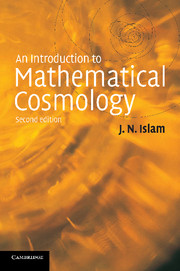Book contents
- Frontmatter
- Contents
- Preface to the first edition
- Preface to the second edition
- Dedication
- 1 Some basic concepts and an overview of cosmology
- 2 Introduction to general relativity
- 3 The Robertson–Walker metric
- 4 The Friedmann models
- 5 The Hubble constant and the deceleration parameter
- 6 Models with a cosmological constant
- 7 Singularities in cosmology
- 8 The early universe
- 9 The very early universe and inflation
- 10 Quantum cosmology
- 11 The distant future of the universe
- Appendix
- Bibliography
- Index
8 - The early universe
Published online by Cambridge University Press: 03 February 2010
- Frontmatter
- Contents
- Preface to the first edition
- Preface to the second edition
- Dedication
- 1 Some basic concepts and an overview of cosmology
- 2 Introduction to general relativity
- 3 The Robertson–Walker metric
- 4 The Friedmann models
- 5 The Hubble constant and the deceleration parameter
- 6 Models with a cosmological constant
- 7 Singularities in cosmology
- 8 The early universe
- 9 The very early universe and inflation
- 10 Quantum cosmology
- 11 The distant future of the universe
- Appendix
- Bibliography
- Index
Summary
Introduction
As mentioned in Chapter 1, the ‘cosmic background radiation’ discovered originally by Penzias and Wilson in 1965 provides evidence that the universe must have gone through a hot dense phase. We have also seen that the Friedmann models (described in Chapter 4), if they are regarded as physically valid, predict that the density of mass-energy must have been very high in the early epochs of the universe. In fact, of course, the Friedmann models imply that the mass-energy density goes to infinity as the time t approaches the ‘initial moment’ or ‘the initial singularity’, at t = 0. This is what is referred to as the ‘big bang’, meaning an explosion at every point of the universe in which matter was thrown asunder violently, from an infinite or near infinite density. However, the precise nature of the physical situation at t = 0, or the situation before t = 0 (or whether it is physically meaningful to talk about any time before t = 0) – these sorts of questions are entirely unclear. In this and the following chapter we shall try to deal partly with some questions of this kind. In the present chapter we simply assume that there was a catastrophic event at t = 0, and try to describe the state of the universe from about t = 0.01 s until about t = one million years. This will be our definition of the ‘early universe’, which specifically excludes the first hundredth of a second or so, during which, as we shall see in the next chapter, and as speculations go, events occurred which are of a very different nature from those occurring in the ‘early universe’ according to the definition given here.
- Type
- Chapter
- Information
- An Introduction to Mathematical Cosmology , pp. 128 - 165Publisher: Cambridge University PressPrint publication year: 2001

